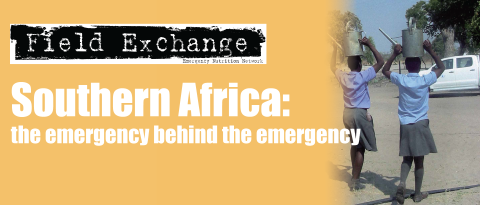Improving food security in vulnerable households in Swaziland
Summary of evaluation1

Proportional piling as part of training in food security assessment
From 2002 to the end of 2005, the Finnish Red Cross and the Finnish Government supported a food security pilot project implemented by the Baphali Swaziland Red Cross Society, with assistance of the International Federation of the Red Cross and Red Crescent. The project was carried out in three different areas in Swaziland. The objective of the project was to make vulnerable households food secure by improving their food production and increasing their income - thereby reducing their vulnerability to droughts and other disasters including HIV/AIDS. Swaziland has a high incidence of HIV/AIDS with an estimated 39% of adults affected at the end of 2003. Furthermore, some 66 per cent of the population lives below the poverty line. This has bred a vicious cycle; reduced ability to cope with the effects of drought due to the prevalence of HIV/AIDS, and weakness brought on by drought, in turn compounding people's risk of exposure to HIV/AIDS.
Four types of project were undertaken within the overall programme; communal gardens, individual backyard gardens, communal fish ponds, and communal poultry production.
As a crucial first step, individuals within the community made land available with permission from the chief, which was then cleared and fenced by the project members. Financial assistance was provided for project infrastructure, e.g. construction of dams and ponds, irrigation pumps, etc. Apart from the backyard gardens, a committee within each community, selected by the project members, managed all of the projects. Training was offered in the areas of food preservation techniques, agricultural skills and project management.
A review of the project led to a number of findings. These included the following; Approximately three quarters of the crops from the communal gardens and individual backyard gardens were consumed directly by household members of the project. The remainder was shared with vulnerable people, bartered or sold. Cash earnings were used to purchase school material and essential nonfood household items and to pay for medical consultations and transport.
In cases where the soil on project sites was too poor for farming purposes, the introduction of poultry production served to optimise land use and provided a viable means of reducing vulnerability. The projects generated income, strengthened coping strategies and were sustainable. Some communities used the income earned to expand their operations into egg production. Larger scale contracts to supply supermarkets were also being developed, however their impact has yet to be determined.
The fish production project ran into some difficulties, due primarily to poor water retention in the fish ponds.
Not all projects were equally successful. Individual backyard gardens provided almost immediate results, while some of the collective projects required a longer timeframe before delivering the desired benefits. The communal projects, nevertheless, led to important contributions in sustaining social networks - including the desire and ability to assist the ill, elderly and orphaned.

Focus group discussion
Among the lessons learned and recommendations for project replication were the following;
- Selection through Home Based Care Facilitators can be a very effective way of identifying vulnerable families.
- Project membership issues need to be clarified at the outset - preferably by way of an agreed constitution and rules of operation.
- Numbers of projected beneficiaries need to be carefully estimated in order to ensure adequate material for project implementation. For example, in the garden projects the number of members per household was underestimated (from seven to ten with more than half of them children)
- Ongoing planning needs to take into consideration the possibility that communal projects may suffer a decrease in membership over time, e.g. due to mortality amongst AIDS sufferers.
- The compromised physical condition of individuals in communities with high rates of HIV/ AIDS needs to be taken into account, e.g. motorised equipment, plastic water containers instead of concrete ones that were supposed to be selfconstructed.
- A proper exit strategy should be developed at project inception. This should ensure a six month phase out plan, clarification of ownership and responsibilities in relation to capital assets, and recommendations regarding ways in which to secure support from other donors if necessary.

Collecting water from a house roof
There were also a number of recommendations with respect to sustainability of the project. These included;
- The national society divisions and branches should be involved during the planning and implementation period to enable project sustainability once external funding has ceased.
- Youth should be involved with their parents whenever possible to ensure skills transfer and sustainability when parents can no longer participate.
- Water availability was generally a problem and was one of the main threats to sustainability. In drought prone areas, diversified project interventions that include a combination of crop and animal husbandry activities should be encouraged.
- Attention needs to be paid to location and quality of land being allocated - in this project, land was not always ideal or desirable, e.g. excessive distances to water sources and difficulty of access for the elderly.
- It is important to ensure a sufficient period of time for implementation in order to maximise sustainability. Community projects may require more time (two to four years) than individual backyard gardens (one to two years).
For more information, contact Mija-tesse Ververs, IFRC, Geneva, email: Mija.Ververs@ifrc.org
1Swaziland: Good field practices to share and replicate. International Red Cross and Red Crescent Societies, 2006.
Imported from FEX website


